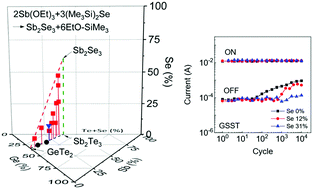Chemical interactions in the atomic layer deposition of Ge–Sb–Se–Te films and their ovonic threshold switching behavior†
Abstract
Ge–Sb–Se–Te (GSST) quaternary films were prepared through atomic layer deposition (ALD) to ensure their amorphous stability for ovonic threshold switching (OTS) applications. Se, a typical phase-change material, was incorporated into Ge–Sb–Te (GST) films using Sb (OC2H5)3 and [(CH3)3Si]2Se precursors. The process produces highly conformal, uniform films consisting of stoichiometric binaries of GeTe2, Sb2Te3, and Sb2Se3. A detailed analysis of the atomic compositions revealed Te substitution for Se on the film surface through the ligand exchange reaction between the Te and Se precursors. Comparative experimental and simulation studies on the OTS behaviors showed that Ge and Se increase the optical bandgaps while Se decreases the density of the localized states. The amorphous stability of the Se-containing films enhances the cycling endurance of the OTS device up to 105 cycles. As conformality and atomic-level accuracy in terms of thickness and composition are prerequisites for three-dimensional crossbar-type passive arrays, the ALD process and the OTS performance presented in this work have a high potential utility for constructing a selector element in non-volatile high-density memories.



 Please wait while we load your content...
Please wait while we load your content...